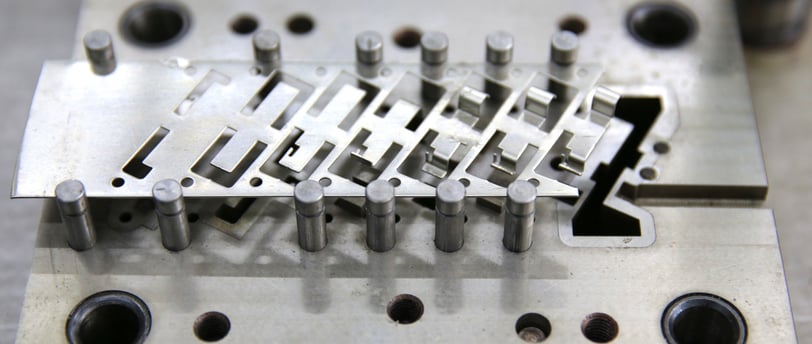The Role of Stamping Die in Precision Hardware Processing
2/9/2025


Introduction to Stamping Dies
Stamping dies play a crucial role in the production of precise hardware components, especially in industries like automotive, aerospace, and electronics. At their core, stamping dies are specialized tools used to shape or cut materials, predominantly metal sheets, through mechanical presses. Their design and operation are fundamental to facilitating accurate and efficient manufacturing processes.
In general, there are several types of stamping dies, each serving specific functions. Single-station dies, for example, accomplish one operation, such as cutting a particular shape from a metal sheet in a single press stroke. In contrast, progressive dies contain multiple stations within a single die setup, allowing for several operations to be performed sequentially as the material progresses through the system. This type promotes higher production rates and reduces handling time, providing a significant advantage for mass production.
Additionally, compound dies allow for two operations—typically cutting and forming—to occur simultaneously, enhancing production efficiency while maintaining precision. Each of these dies is designed to ensure that the stamped parts adhere to tight tolerances and dimensional requirements, underscoring the importance of precision in hardware processing. The ability of stamping dies to produce high-quality, consistent results is essential in manufacturing, ensuring that each component fits perfectly within larger assemblies.
Ultimately, as industries continue to evolve, the demand for precision hardware components remains paramount. Stamping dies not only contribute to achieving the high levels of accuracy and consistency required but also support innovation in manufacturing techniques. Understanding the various types of stamping dies and their functionalities is essential for appreciating their significant role in the landscape of modern industrial production.
Key Applications of Stamping Dies in Hardware Processing
Stamping dies play a crucial role in the precision hardware processing industry, serving various applications across multiple sectors. One of the most significant areas where these dies are utilized is in the automotive industry. Here, complex components such as body panels, brackets, and housings are manufactured in high volumes with unparalleled accuracy. The ability to produce parts that meet stringent quality standards and dimensional specifications is essential in this competitive field. For instance, companies often rely on progressive stamping dies to allow for the seamless transition from one stage of manufacturing to another, minimizing material waste and increasing productivity.
The aerospace sector also benefits substantially from the capabilities of stamping dies. Components like airframe structures and interior fittings demand not only precision but also adherence to safety regulations. The intricate designs often necessitate the use of specialized stamping dies that can handle complex geometries without compromising strength and durability. For example, customizing dies to accommodate various lightweight materials reflects the industry's shift towards enhancing fuel efficiency while maintaining structural integrity.
In the electronics industry, stamping dies are pivotal in producing intricate parts such as connectors, housings, and circuit boards. The demand for smaller, more efficient electronic devices drives the need for dies that can create detailed features and precise tolerances. Advances in stamping technology enable manufacturers to achieve high production rates without reducing quality, ensuring that the final products meet the fast-paced innovation cycle of the electronics market.
Lastly, consumer goods manufacturers use stamping dies extensively for producing everyday items, ranging from kitchenware to appliances. The versatility of stamping dies allows for the efficient mass production of diverse products while maintaining cost-effectiveness. In summary, stamping dies are essential for ensuring precision and efficiency across various applications in hardware processing, reinforcing their position as a backbone of modern manufacturing.
Factors Influencing the Design of Stamping Dies
The design of stamping dies is a critical aspect of precision hardware processing, shaped by a multitude of factors that ensure efficiency and effectiveness in production. One of the primary considerations is material selection. The choice of materials directly influences the durability of the die, its ability to withstand wear and tear, and its overall performance. Common materials such as tool steel, carbide, and aluminum alloys are often assessed based on their mechanical properties, cost, and the specific requirements of the stamping process. Selecting the appropriate material is crucial for achieving desired tolerances and ensuring longevity in operations.
Another significant factor in die design is die configuration. The arrangement of components within the die affects how the material flows during the stamping process. This configuration must align with the specific geometry of the hardware being produced, as complex shapes may require unique die designs to ensure precision. Furthermore, tolerances must be meticulously defined, as the precision of the stamped parts relies heavily on the die's ability to maintain tight tolerances throughout its service life. This necessitates rigorous testing and validation processes to confirm that the dies can consistently produce components that meet quality standards.
Incorporating design for manufacturability (DFM) principles into stamping die design can enhance production efficiency. DFM involves optimizing the design so that it simplifies the manufacturing process, ultimately reducing costs and time. This alignment is especially relevant in today’s context, where advancements in technology, including CAD software and CNC machining, allow for more precise modeling and simulation of dies. These tools empower designers to visualize potential issues and make informed decisions before the production phase begins, ensuring that the final product meets the stringent demands of modern manufacturing practices.
Future Trends in Stamping Die Technology
As the manufacturing industry progresses, stamping die technology is witnessing significant advancements that will reshape the landscape of precision hardware processing. One of the key trends is the development and use of advanced materials for stamping dies. Innovations in high-strength steel, carbide, and composite materials are enhancing the durability and performance of these tools. These materials not only improve the lifespan of the dies but also allow for more complex geometries and nuances in designs, enabling manufacturers to achieve higher levels of precision.
Another notable trend is the increasing integration of automation within the stamping process. The adoption of robotic systems and computer numerical control (CNC) technology streamlines operations and enhances the efficiency of die changes and maintenance. This automation not only accelerates production cycles but also minimizes human error, ensuring consistently high-quality output. Moreover, the introduction of smart technology, including the Internet of Things (IoT), facilitates real-time monitoring and data collection, providing manufacturers with valuable insights into their operations.
Sustainability is also becoming a cornerstone of stamping die technology, as companies are increasingly prioritizing eco-friendly practices. The shift towards recyclable materials and energy-efficient manufacturing processes not only reduces the environmental impact but also aligns with the growing demand for sustainable products in the market. Manufacturers are exploring ways to minimize waste generated during the die manufacturing process and are investing in technologies that promote resource efficiency.
In conclusion, the future of stamping die technology is poised for transformative changes driven by advancements in materials, automation, and sustainability. As industries adapt to these trends, the precision hardware processing sector is likely to witness enhanced efficiency, productivity, and environmental responsibility, positioning stamping dies at the forefront of manufacturing innovation.
